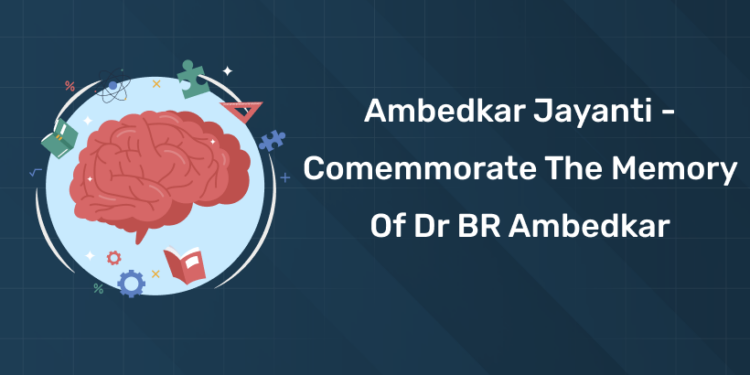Table of Contents
Ambedkar Jayanti 2025 or Bhim Jayanti is a year on year festival observed on 14 April in memory of B. R. Ambedkar. It marks India’s political leader Dr. B.R. Ambedka’s birthday who was born on the 14th of April in the year 1891. An Official public holiday is observed throughout India since 2015 on this day. Ambedkar Jayanti is celebrated not just in India but all around the globe. Dr. B.R. Ambedkar, also known as Babasaheb, was born on April 14, 1891, in the town of Mhow, which is now officially known as Dr. Ambedkar Nagar, located in Indore district, Madhya Pradesh. His father’s name was Ramji. He was the 14th child of his parents. His birthday is celebrated as Dr. B.R. Ambedkar’s remembrance Day in India since 2015. So this year also India is going to celebrate Ambedkar Jayanti 2025 and Commemorate the Memory of Dr.B.R. Ambedkar on April 14, 2025.
Get Free Mock Tests for various Competitive Exams !!!
Ambedkar Jayanti 2025 – Commemorate the Memory of Dr. B. R. Ambedkar
On this blessed day, processions are carried out by his followers at Chaitya Bhoomi in Mumbai and Deeksha Bhoomi in Nagpur. Senior national figures, like the President, Prime Minister and leaders of major political parties, pay homage at the statue of Ambedkar at the Parliament of India in New Delhi. This day is celebrated throughout the world especially by Dalits, Adivasi, labor workers, women and also those who embraced Buddhism after him.
Babasaheb’s first birthday was publicly celebrated in the year 1928 in Pune, by social activist and Ambedkarite Janardan Sadashiv Ranapisay. He started the tradition of Babasaheb’s birth anniversary that day. First Online Jayanti Celebration was also Babasaheb’s birthday celebration.
Get Free Mock Tests for various Banking Exams !!!
Ambedkar Jayanti 2025 Theme
1: Who was the first woman President of India?
The theme for Ambedkar Jayanti 2025 is “Equality for All: Celebrating Justice, Dignity, and Rights.” This theme focuses on Dr. B.R. Ambedkar’s lifelong mission to ensure equal rights and social justice for every citizen. It encourages reflection on the importance of dignity, human rights, and inclusion in building a fair society. The theme also highlights the continued relevance of Ambedkar’s vision in addressing modern challenges like discrimination and inequality. It calls on individuals and communities to uphold his values through education, unity, and action.
Previous Year Themes
2024 – Economic Equality and Social Justice for All
2023 – Dr. Ambedkar’s Ideas on Nation Building
2022 – Building an Inclusive India
2021 – Constitutional Morality and Social Justice
2020 – Justice and Equality through the Constitution
Free UPSKILLING Courses!
Take your first step toward mastering in-demand skills, acing interviews, and securing top-tier jobs with Entri's free upskilling courses.
Start Learning!Interesting facts about Babasaheb
Given below some of the interesting facts about Babasaheb that we can remember on Ambedkar Jayanti 2025 and Commemorate the Memory of Dr.B.R.Ambedkar.
- He is an eminent constitutional lawyer, with high influence on economics and political issues, a statesman, an author, an activist and an architect of the Indian Constitution.
- He is always remembered as the unquestionable leader of the depressed classes.
- On October 14, 1956, Dr. Ambedkhar embraced Buddhism.
- Many did not forget him for lifting them out of dust and teaching them the way to self-respect and dignity.
- His parents were Ramji and Bhimbai Sakpal. He was called Bhima in childhood, and the name Bhimaro stuck to him after he completed his college.
- Both his father and grandfather were in the army of the British Government. Both were educated as in those days the British Government had made education compulsory for the people in their army.
- Bhim married nine-year-old Ramabai when he was 17. The marriage was held, in an open market shed in Byculla, Bombay.
- Maharaja of Baroda, Sayaji Rao Gaikwad, granted a scholarship that enabled Ambedkar to attain the degree of Bachelor of Arts in the year 1912 as Bhim’s father was very poor to pay for his education.
- After the death of his father, Ramji, the responsibility of the entire family rested on Bhim’s young shoulders. Once again, the Maharaja of Baroda, came to his aid sent Bhim to America for his higher studies in return for serving the State of Baroda for ten years.
- He became a father figure to the poor and low-class people. He got the name “Babasaheb” out of respect from these people.
- He struggled to secure for the untouchables the right to use the public tanks and entry to the temples.
- Ambedkar was also invited to represent the cause of the untouchables in Simon Commission’s Round Table Conference.
- He was invited again for the second session of the Round Table Conference by the British Government and was on the Federal Structure Committee, and was entrusted with the task of drafting the future “Constitution of India” Mahatma Gandhi too participated in this meeting.
- In November 1932, Dr. Ambedkar attended the third session of the Round Table Conference. In August 1936, he established his new political party with the name “Independent Labour Party”.
- The elections took place on February 17, 1937. Ambedkar with many of his members won this election with the majority. He abolished the “Khoti or Khot” system of land in the ‘Konkan’ region.
- In April 1947 Babasaheb submitted to the Assembly a draft on “States and Minorities”. The Constituent Assembly, on April 29, 1947, declared that Untouchability in all forms would be abolished in India.
- The British Parliament passed the Act of Indian Independence on July 15, 1947, and immediately after that the first Cabinet Ministry of Free India was formed and Dr. Ambedkar was invited to join the Cabinet as the Law Minister, which he accepted.
- Ambedkar was called to draft the Constitution of Independent India where he was appointed as the Chairperson. He completed this vast and varied work in February 1948.
- His famous book “The Untouchables” in English was published in October 1948. He also worked on modifying the Hindu Law and submitted the Hindu Code Bill to the Constituent Assembly in 1948.
- News arrived from the United States of America that the famous ‘Columbia University’ had awarded the Doctorate of Law degree to Dr. Ambedkar. Ambedkar went to New York to receive it on June 5, 1952.
- The very next year, on January 12, 1953, the Osmania University of Hyderabad, conferred on him an Honorary Doctorate of Literature.
- Age and ill health did not deter Ambedkar from working non-stop. When he realized that the Hindu System would never grant social equality to his people, he started looking for an alternate religion, which would make his dream come true; a religion where every man was treated as an equal. He found his answer in Buddhism.
- After seeking for a long time and after studying several other religions he finally embraced Buddhism on October 14, 1956.
- By 1956, when he died, he had succeeded in raising his caste fellows from the dust to the dignity of equal citizenship.
- Today in India all the temples, public places are open all the classes. Ambedkar attained “Nirvana” on December 6, 1956, and was awarded “The Bharat Ratna” in the year 1990.
- In the same year when he awarded the Bharat Ratna, his life-size portrait was also unveiled in the Central Hall of Parliament. The period from 14 April 1990 to 14 April 1991 was observed as “Year of Social Justice” in the memory of Dr. B R Ambedkar.
Like every year this year also Ambedkar Jayanti 2025 will be celebrated in India.
Get Free Mock Tests for various Government Exams !!!
Ambedkar Jayanti Quiz 2025
A) 1889
B) 1891
C) 1893
3. Which Indian city was Dr. Ambedkar born in?
A) Mumbai
B) Nagpur
C) Mhow
A) Leading India’s independence movement
B) Writing the Indian Constitution
C) Founding the Indian National Congress
5. What was the caste background of Dr. Ambedkar?
A) Brahmin
B) Kshatriya
C) Dalit
A) Islam
B) Christianity
C) Buddhism
A) Quit India Movement
B) Dalit Rights Movement
C) Temple Entry Movement
A) 1947
B) 1950
C) 1952
A) Oxford University
B) Columbia University
C) Cambridge University
Want More Engaging Questions?
Download our FREE PDF packed with insightful quiz questions to test your knowledge!
🔽 Click below to get your free copy now! 🔽
Ambedkar Jayanti Quiz 2025 PDF
Ambedkar Jayanti is more than just a commemoration; it is a reminder of the ongoing struggle for equality, justice, and human dignity. As we honor the life and vision of Dr. B.R. Ambedkar, we also recognize the importance of education, social reform, and constitutional values in shaping a fair and inclusive society. His legacy continues to inspire movements against discrimination and efforts to empower marginalized communities.
Let us celebrate Ambedkar Jayanti not only on April 14 but throughout the year by promoting his ideals of liberty, equality, and fraternity. Together, we can build a society where every individual has equal rights, equal opportunities, and a voice that is heard.
Free UPSKILLING Courses!
Take your first step toward mastering in-demand skills, acing interviews, and securing top-tier jobs with Entri's free upskilling courses.
Start Learning!Frequently Asked Questions
What is Ambedkar Jayanti?
Ambedkar Jayanti is the birth anniversary of Dr. B.R. Ambedkar, celebrated every year on April 14. It honors his contributions to Indian society, especially in law, social justice, and equality.
Who was Dr. B.R. Ambedkar?
Dr. B.R. Ambedkar was a social reformer, jurist, economist, and the principal architect of the Indian Constitution. He worked tirelessly for the upliftment of Dalits and marginalized communities.
Why is Ambedkar Jayanti celebrated?
Ambedkar Jayanti is celebrated to pay tribute to Dr. Ambedkar’s role in promoting equality, justice, and democracy. It also spreads awareness about his life, work, and legacy.
When is Ambedkar Jayanti observed?
Ambedkar Jayanti is observed on April 14 every year, marking the birth of Dr. B.R. Ambedkar in 1891.
How is Ambedkar Jayanti celebrated in India?
It is celebrated through public processions, floral tributes at Ambedkar statues, seminars, essay competitions, and events promoting social harmony.
What were Dr. Ambedkar’s major contributions to India?
He led the drafting of the Indian Constitution, fought against caste discrimination, and advocated for social and economic reforms.
Did Dr. Ambedkar belong to any political party?
Yes, he founded the Republican Party of India to represent the interests of the marginalized and promote social justice.
What was Dr. Ambedkar’s role in the Constitution of India?
He served as the Chairman of the Drafting Committee, shaping the Constitution with a strong emphasis on equality and individual rights.
Which religion did Dr. Ambedkar convert to and why?
Dr. Ambedkar converted to Buddhism in 1956 as a protest against caste-based discrimination and to seek spiritual equality.
What is the significance of Chaitya Bhoomi?
Chaitya Bhoomi in Mumbai is the resting place and memorial of Dr. Ambedkar. It is a major pilgrimage site for his followers, especially on Ambedkar Jayanti.












